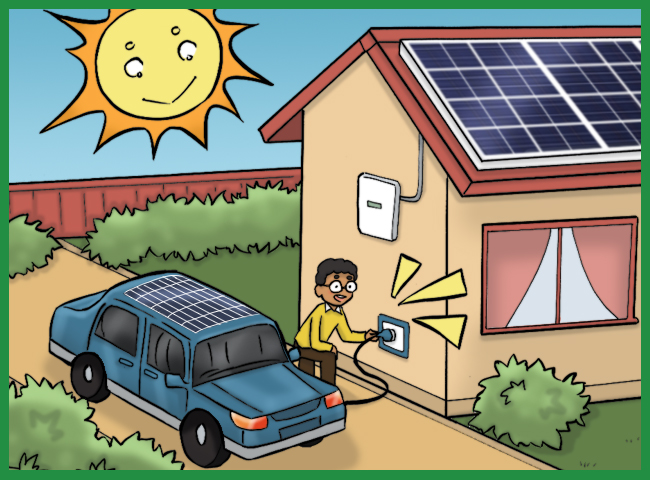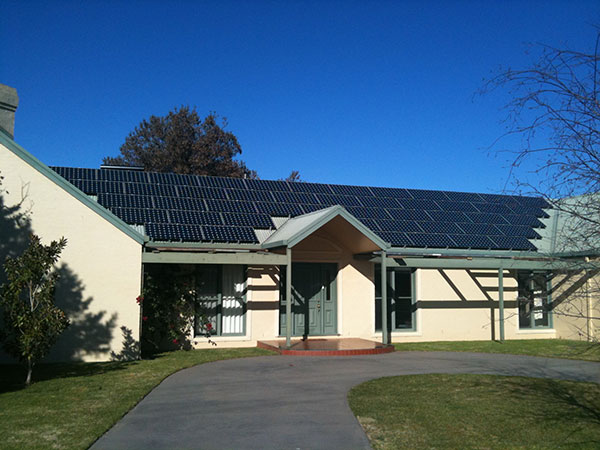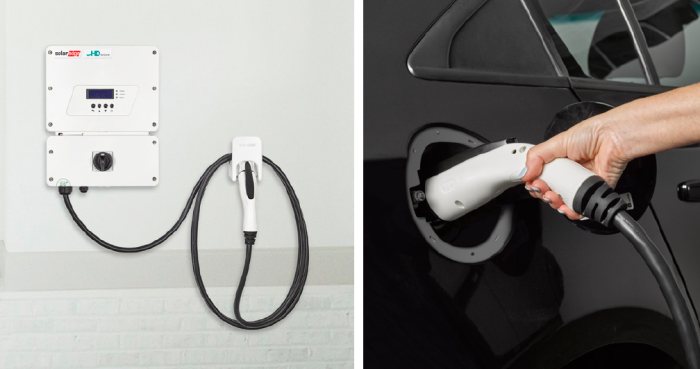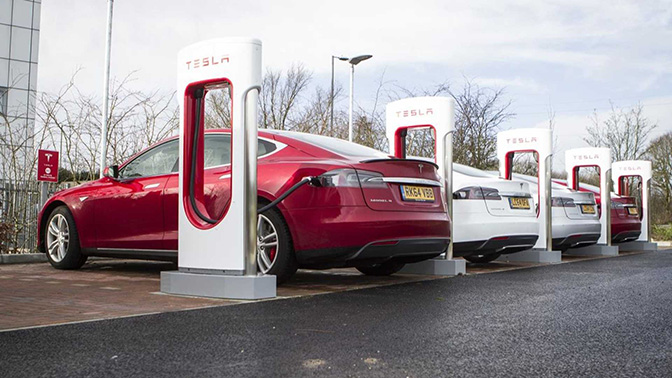The Homeowner’s Guide To Solar And Electric Cars
By Finn Peacock – Chartered Electrical Engineer, Ex-CSIRO, EV Owner & Founder of SolarQuotes.com.au
Last Updated: 17th Apr 2025

I field questions from homeowners about solar power, batteries, and how they tie in with electric vehicles (EVs) almost every day.
I’ve witnessed the solar industry grow in Australia these last 10 years. I believe having a home fully integrated with both energy storage and electric vehicles is one of the “final frontiers” of solar energy.
So, I’ve put together the following guide. Any further questions after reading? Shoot me an email and I’ll update this article.
How many solar panels do you need on your home to support an electric vehicle?
(If you don’t understand the difference between a kilowatt [kW] and a kilowatt-hour [kWh], I strongly advise reading this first.)
Petrol cars have the “L per 100 km” measurement – the amount of fuel a car will consume, on average, to travel 100km. Electric cars also have a similar measurement: “kWh per km”.
This varies from EV to EV. Though on average, most electric cars will get about 6km of range from 1kWh of electricity in their battery pack. The average Australian driver will drive around 50km per day. Therefore, an electric car will need about 8kWh of electricity to recharge what they use.
1kW of solar capacity (around 3 panels these days) will produce, on average per day over a year, 4kWh of electricity. This will be less in the winter, and more in the summer. So, you would need to add around 2kW of solar panels to your roof to offset the charging of an electric car you drive ~50km per day. But there’s more to consider – read on.
Charging your electric car with solar power
The simplest way to charge an electric car using your home’s rooftop solar panels is to plug the car into your home’s EV charger during the day when the sun is shining. You won’t need grid electricity as long as you generate more solar electricity than your EV and other loads in the house need.
However, if you generate less solar energy than what the car and other loads require, grid power will make up the shortfall. Keep this in mind charging your car on a cloudy day with only a small solar power system!
Round trip efficiency, and why 1kWh of solar energy doesn’t equal 1kWh of EV charge
Inefficiencies between solar panels, inverters and the batteries in your car, can cause charging losses of more than 10%.
So if your solar panels generate 1kWh, only 900Wh of that will end up in an EV’s battery pack. Therefore, you may want to install more solar panels than you think you need to compensate for these charging losses.
Using battery storage to charge your electric car at night
A home battery charged with solar power during the day could charge your EV at night with its stored energy. But this type of heavy usage will shorten the life of a solar battery. However, the technology is getting better in this regard. Additionally, losses (touched on above) mount up between solar panels to home battery, then from home battery to EV charging.
I’m building a new home – should I put in single-phase or three-phase power?
If you are building a new home, consider three-phase power. This will allow you to put in a much larger solar array. Then you will be able to reliably supply the ‘home of the future’ that has high electricity needs due to a household battery and one (or more) electric vehicles.
A house with a huge 10kW system
Home charging and the difference between Level 1, 2 and 3 chargers
You can learn everything you need to know about charging an electric car in my EV Charging 101 Guide. However, here’s a brief summary.
Electric car chargers are divided into three levels, where ‘level 1’ is the slowest form of charging and ‘level 3’ is the fastest.
Level 1
Level 1 charging is the slowest rate that’s normally possible and uses a standard 10 amp power point. This will allow around 12 kilometers of range to be added to an electric car per hour. So, if you park for 10 hours overnight, a ‘level 1’ charger will add ~120 kilometers of range. Charging from a 15 amp power point requires a special plug which provides up to around 18 kilometres of range per hour. This is because it can charge at a rate closer to 3kW compared to ~2kW from a 10 amp power point.
Level 2
Level 2 charging involves installing a specialised EV charger in your home. At a 7kW charging rate it can add around 40 kilometers of range to an EV per hour on single-phase. On three-phase it can even add 130km of range (22kW charging rate). There are many brands of EV chargers available, and expect to pay $1,700 – $2,500 to get one installed. This is assuming you do not also need a switchboard upgrade.
Be warned that your EV manufacturer may require a level 2 charger to be installed where the car is kept in order for it to stay in warranty.
You can compare home charging solutions available in Australia using my EV Charger Comparison Table.
A ‘level 2’ SolarEdge EV charger. Image credit: SolarEdge
Level 3
Level 3 charging is rapid charging using dedicated public chargers. Probably the best known example of a ‘level 3’ charger is the Tesla SuperCharger:
A ‘level 3’ Tesla SuperCharger. Image credit: Tesla
These types of chargers are most likely to be used by people traveling long distances, or those caught short, as they can add up to 720 km of range per hour.
An important thing to keep in mind is not all electric vehicles are able to fully utilise the charging capabilities of a ‘level 3’ charger. If you plan on taking your EV on long trips with the help of a ‘level 3’ charger network, you’ll want to make sure that your chosen car will be able to make use of them. Overuse of a level 3 charger can also impact the life of your vehicle’s battery pack.
“Range anxiety” and charging when away from home
A typical car petrol tank can be filled at a service station in a couple of minutes. You’re never too far from a petrol station, so being caught out low on fuel is usually something that only happens to people travelling long distances in rural areas.
In comparison, even the more common ‘level 3’ EV chargers will take around 30 – 45 minutes to completely charge a car with a large battery, and far longer if you’re charging at ‘level 2’ or even ‘level 1’ rates.
The challenges of slow charging speeds of electric cars and the comparative current rarity of ‘level 3’ fast EV chargers is commonly expressed as ‘range anxiety’ – the fear your car has insufficient charge to reach its destination, or will be unable to charge fast enough to reach a destination on time.
Personally, I think ‘range anxiety’ fears are overblown, as anyone who understands their own driving habits and has the ability to plan ahead will almost never be caught out with a flat EV battery.
Many households these days have two cars – so a solution to range anxiety can be to keep a petrol car for long trips or for use when an EV is flat, and the electric vehicle for shorter trips around town.
If you find yourself out and about with low charge and there’s no public ‘level 3’ rapid public charger available, caravan parks have 15 amp power points (providing ‘level 1’ charge), and you can also use three-phase sockets at some businesses and showgrounds.
Some of these locations are publicly advertised EV charging points – others are ones that you must ask nicely if you can charge your car there!
The final word
When it comes to sizing a solar power system for an electric vehicle, there’s a number of things you need to think about:
- The make/model of an EV and its specifications.
- Average distance driven and the driving habits of those who will be using the car.
- The energy usage of your household, and whether you plan to add home battery storage or more EVs in the future.
As mentioned, the average Australian driver will only need about an extra 2kW of solar power on their home to offset their daily driving consumption.
But …
Because of other factors, I firmly believe a household should install as much solar as they reasonably can. A ‘house of the future’ with a large battery and multiple EVs could easily gobble up the output of even a large 10kW solar system.
If you are going to charge your electric car via anything other than a standard wall socket, you’ll want at least 13 kW of solar panels in total and a 10 kW inverter to make the most of solar energy.
Thinking of installing solar panels for your home and adding an EV in the future? Already have an electric car and want to add solar and/or a dedicated EV charger? SolarQuotes can help you get quotes from high-quality installers quickly and easily:


